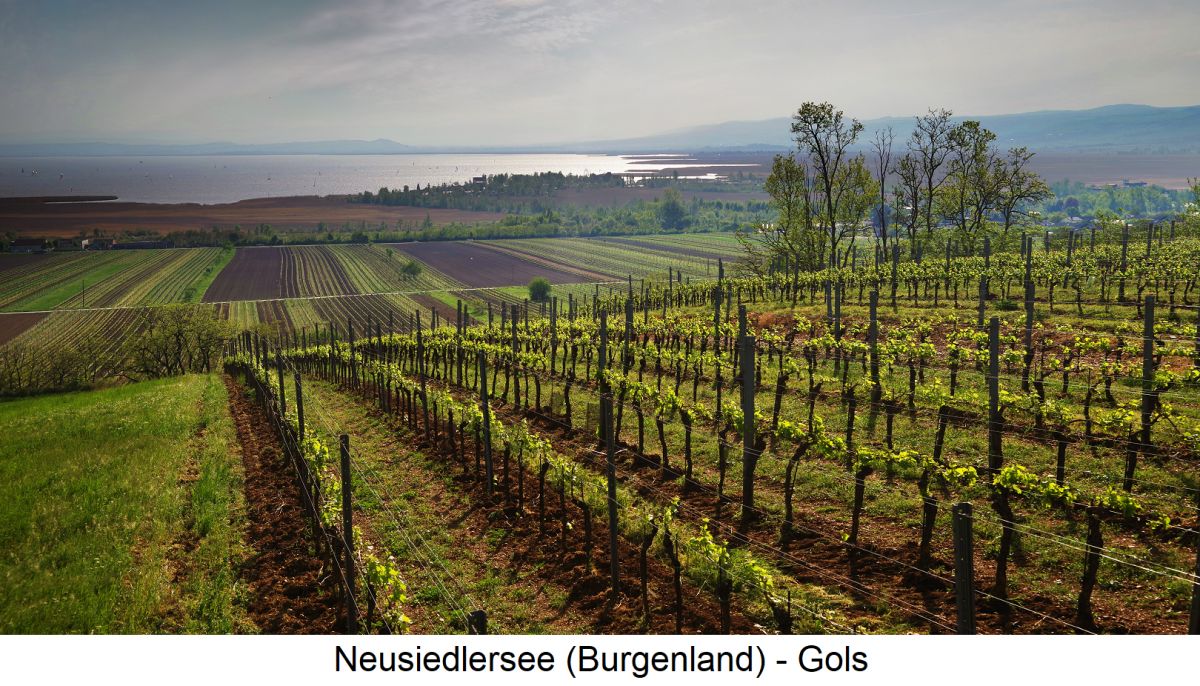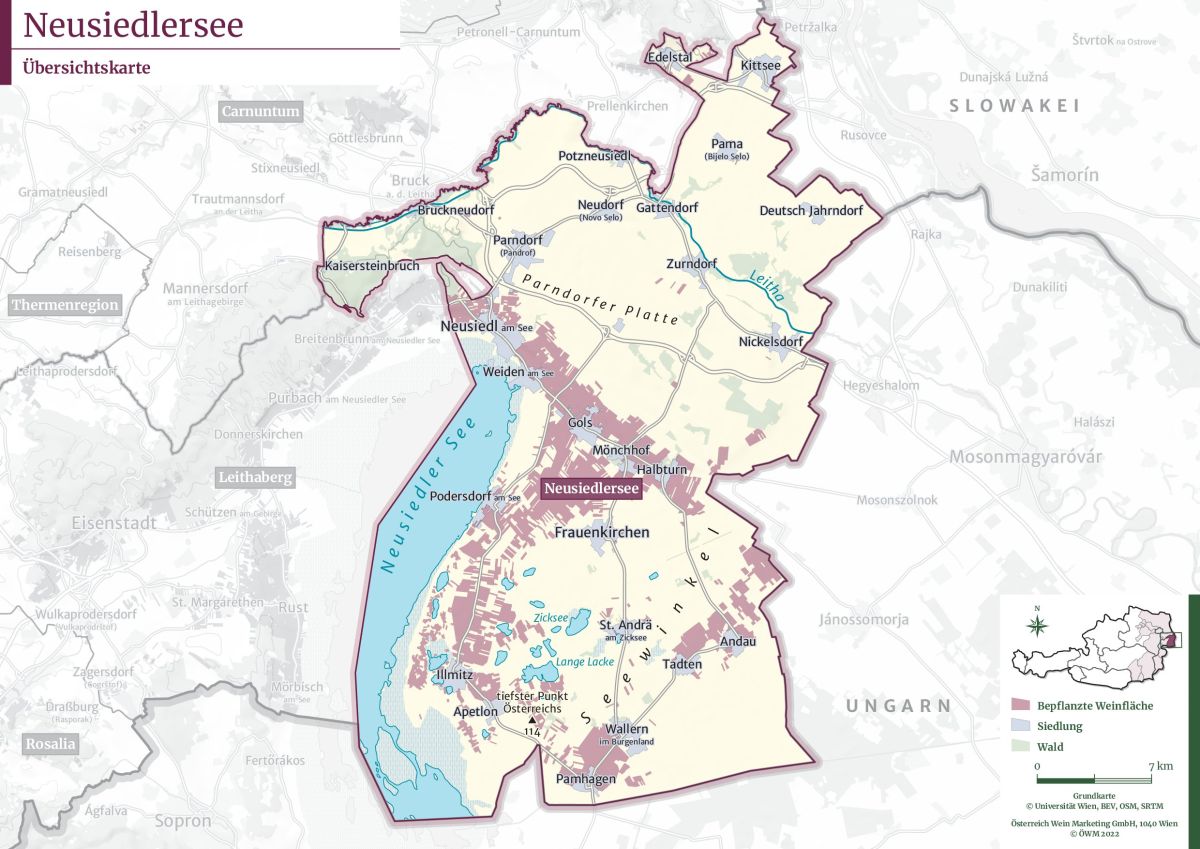Results
2,284 Results
Loading more Results ...
Loading more Results ...
| Neusiedlersee |
Description to Neusiedlersee
One of the six specific wine-growing regions in the Austrian province or generic wine-growing region of Burgenland. It was restructured in 2016 with some changes to the names and area boundaries. Apart from that, the name remained the same. Some areas of the Neusiedlersee wine-growing region were assigned to the Leithaberg wine-growing region (formerly Neusiedlersee-Hügelland). These were the municipalities of Jois and Winden, as well as some vineyards in the municipality of Neusiedl am See. The area is named after the 320 km² large and 36 kilometre long steppe lake. In the vernacular, it is usually referred to as Seewinkel because it nestles at an angle to the lake. It stretches from the north of the province along the northern and the entire eastern shore of the lake to the border with Hungary.

Climate & soils
Like all bodies of water, Lake Neusiedl has a positive effect on viticulture. The climate is characterised by Pannonian and continental influences, the large Lake Neusiedl has a climate-regulating effect and acts as a heat reservoir in autumn in conjunction with the lake mists that occur. This contributes to the formation of botrytis (noble rot) and thus to the production of noble sweet wines, which have a very long tradition in this region. The vegetation cycle is longer than average at up to 250 days a year. The predominant soil types are loess, black earth, gravel and sand.
Wine-growing communities & vineyards
Well-known wine-growing communities are Andau, Apetlon, Edelstal, Frauenkirchen, Gols (one of the largest in Austria), Halbturn, Illmitz, Kittsee, Mönchhof, Neusiedl am See (only part of the vineyards), Tadten, Pamhagen, Podersdorf, St. Andrä, Wallern and Weiden. The "Seewinkel Wine Route" begins at Neusiedl am See and runs along the Hungarian border, past the "Lange Lacke" nature reserve and back to Neusiedl. The best-known vineyards include Altenberg, Alte Satz, Bless, Edelgrund, Gabarinza, Goldberg, Hallebühl, Heideboden, Kreuzjoch, Neuberg, Reitäcker, Salzberg, Schafleiten, Siebenmahd, Spiegel, Spitzerberg, Straßenäcker, Ungerberg and Zwickeläcker.

Grape variety index
In 2022, the vineyards covered a total of 6,110 hectares of vines. Compared to 2017 with 6,675 hectares, this was a reduction of 565 hectares (8.5%). The proportion of red wine varieties is 49%, the proportion of white wine varieties 51%. The dominant variety, accounting for around a quarter of the total area, is the red wine variety Zweigelt, followed by the two varieties Grüner Veltliner and Welschriesling (which swapped places), as well as Blaufränkisch and Chardonnay.
Grape variety
|
in Austria
|
colour |
HA
|
%
|
HA
|
%
|
| Zweigelt | Blauer Zweigelt, Rotburger | red | 1.461 | 24 | 1.605 | 24,0 |
| Grüner Veltliner | Weißgipfler | white | 609 | 10 | 696 | 10,4 |
| Welschriesling | - | white | 605 | 9,9 | 739 | 11,1 |
| Blaufränkisch | - | red | 535 | 8,8 | 619 | 9,3 |
| Chardonnay | Morillon - not used in Bgld | white | 448 | 7,3 | 442 | 6,6 |
| White Burgundy | Pinot Blanc, Klevner | white | 271 | 4,4 | 315 | 4,7 |
| St Laurent | - | red | 223 | 3,6 | 278 | 4,2 |
| Merlot | - | red | 220 | 3,6 | 183 | 2,7 |
| Sauvignon Blanc | - | white | 189 | 3,1 | 148 | 2,2 |
| Muscat Ottonel | - | white | 175 | 2,9 | 183 | 2,7 |
| Cabernet Sauvignon | - | red | 169 | 2,8 | 158 | 2,4 |
| Bouvier | - | white | 166 | 2,7 | 165 | 2,5 |
| Müller-Thurgau | Rivaner | white | 141 | 2,3 | 181 | 2,7 |
| Blue Burgundy | Pinot Noir, Pinot Noir | red | 125 | 2 | 144 | 2,2 |
| Muscat | Yellow M., Red M. / Muscat Blanc | white | 120 | 2,0 | 81 | 1,2 |
| Scheurebe | Seedling 88 | white | 108 | 1,8 | 138 | 2,1 |
| Roesler | - | red | 99 | 1,6 | 90 | 1,3 |
| White Riesling | Riesling Rhine Riesling | white | 59 | 1,0 | 83 | 1,2 |
| Grey Burgundy | Pinot Gris, Ruländer | white | 58 | 1 | 63 | 0,9 |
| Traminer | Gewürztraminer, Roter T., Gelber T. | white | 49 | 0,8 | 66 | 1,0 |
| Cabernet Franc | - | red | 47 | 0,8 | 28,3 | 0,4 |
| Blue Burgundy | - | red | 41 | 0,7 | 60 | 0,9 |
| Neuburger | - | white | 33 | 0,5 | 65 | 1,0 |
| Syrah | Shiraz | red | 37 | 0,6 | 40 | 0,6 |
| Rathay | - | red | 19 | 0,3 | 18 | 0,3 |
| Gold muscatel | - | white | 14,3 | 0,2 | - | - |
| Blossom muscatel | - | white | 9,1 | 0,1 | - | - |
| Gold burger | - | white | 7,5 | 0,1 | 22 | 0,3 |
| Furmint | - | white | 3,3 | 0,1 | 1,5 | - |
| Souvignier Gris | - | white | 2,5 | - | - | - |
| Frühroter Veltliner | Malvasia | white | 2 | - | 6,7 | 0,1 |
| Rose muscatel | - | red | 2 | - | - | - |
| Muscaris | - | white | 1,3 | - | - | - |
| Sylvaner | Green Sylvaner | white | 0,5 | - | 1,0 | - |
| Zierfandler | Late red | white | 0,5 | - | 0,3 | - |
| Rotgipfler | - | white | 0,2 | - | 0,4 | - |
| Blauer Portugieser | - | red | - | - | 0,5 | - |
| Jubilee vine | - | white | - | - | 2,7 | - |
| remaining varieties | - | white/red | 65 | 2,1 | 54 | 1,5 |
WHITE VARIETIES |
3.116 |
51 |
3.448 |
52 |
||
RED VARIETIES |
2.994 |
49 |
3.227 |
48 |
||
TOTAL |
6.110 |
6.675 |
|
DAC system
From the 2011 vintage, the Neusiedlersee DAC origin-controlled quality level was introduced for dry red wines made from Zweigelt. Since the 2020 vintage, sweet wines have also been allowed to use the DAC designation. In addition to the generally applicable DAC conditions, special rules apply. All other quality wines must be marketed with the Burgenland designation of origin, while regional wines must be marketed under the wine-growing region designation Weinland. The indication of the narrower origin "Seewinkel" is permitted if the grapes come from the municipalities of Apetlon, Illmitz and/or Podersdorf. The date for the application to obtain the state inspection number is staggered. If the decision is favourable (usually within one week), the grapes may be marketed. There are two categories: Classic and Reserve:
ClassicThe red wines must be made from at least 85% Zweigelt. They may be matured in stainless steel tanks or large wooden barrels. The residual sugar must not exceed 4 g/l, the alcohol content must be at least 12% vol. The designation of a vineyard is not permitted. The wines must have a fruity and spicy flavour typical of the variety. The application may be submitted from 1 February of the year following the harvest at the earliest.
All white quality wine grape varieties are authorised for the fruit-sweet white wines. The categories Spätlese or Auslese with their wine law conditions are possible. The residual sugar must be at least 45 g/litre. The application may be submitted from 1 January of the year following the harvest at the earliest.
ReserveRed wines must be made from at least 85% Zweigelt. They may be matured in large wooden barrels or in barriques. The residual sugar must not exceed 4 g/l, the alcohol content must be at least 13% vol. The wines must have a fruity, spicy and strong flavour typical of the variety. Applications may be submitted from 1 February of the second year following the harvest at the earliest.
All white quality wine grape varieties are authorised for the noble sweet white wines. The categories Beerenauslese or Trockenbeerenauslese with their wine law conditions are possible. The residual sugar must be at least 45 g/litre. Applications may be submitted from 1 April of the year following the harvest at the earliest.
Producers
Well-known producers are Achs Paul, Achs Werner, Beck Judith, Berger Leginthov, Bernthaler + Bernthaler, Bruckner Helmut, Bruckner Reinhard, Goldenits Richard, Goldenits Robert, Gsellmann Andreas, Gsellmann Matthias, Gsellmann Siegfried, Haider Gerhard, Hareter Thomas, Heinrich Gernot, Heiss Franz, Juris - Stiegelmar, Kracher Weinlaubenhof, Kroiss Walter, Lang Helmut, Lehner Erwin, Leitner Gernot, Lentsch Franz, Lentsch Josef, Meinklang - Weingut Michlits, Moser Sepp, Münzenrieder Johann, Nekowitsch Gerhard, Nittnaus Gebrüder, Nittnaus Anita & Hans, Opitz Willi, Pasler Martin, Pittnauer Gerhard, PMC, Pöckl René, Preisinger Claus, Preisinger Georg, Preisinger Helmut, Renner Helmuth, Rittsteuer Paul, Rommer Michael, Salzl - Seewinkelhof, Scheiblhofer, Schloss Halbturn, Schmelzer Horst and Georg, Schmelzer Georg - Köllan, Schwarz Johann, Stölzerhof-Tschida, Szigeti, Temer Christian, Tschida-Angerhof, Tschida Christian, Umathum, Varga Gerhard, Velich Heinz, Waltschek, Wegleitner Johann, Weiss Christian, Weiss Manfred, Weiss Markus, Wendelin Andreas, Wendelin Paul, Wurzinger Josef and Zantho. Associations are Pannobile, Pannonischer Reigen, Pannonische Weingärtner Neusiedlersee and Select Gols.
Lake Neusiedl: © ÖWM - Marcus Wiesner
Map: © ÖWM
Classified wine producers in Neusiedlersee 34
find+buy for Neusiedlersee 65
Recent wines 382
 Weingut Ernst Triebaumer
— Burgenland
2015 Neusiedlersee Ried Oberer Wald Blaufränkisch trocken
22.00 €
Weingut Ernst Triebaumer
— Burgenland
2015 Neusiedlersee Ried Oberer Wald Blaufränkisch trocken
22.00 €

 Weingut Gsellmann Andreas
— Burgenland
2019 Neusiedlersee trocken Rosé
9.90 €
Weingut Gsellmann Andreas
— Burgenland
2019 Neusiedlersee trocken Rosé
9.90 €

 Weingut Ernst Triebaumer
— Burgenland
2012 Neusiedlersee Ried Rusterberg Blauburgunder trocken
Weingut Ernst Triebaumer
— Burgenland
2012 Neusiedlersee Ried Rusterberg Blauburgunder trocken

 Weingut Georg Preisinger
— Burgenland
2018 Neusiedlersee Brut Nature "Himmel voller Sterne"
88 WP
very good
Up to 29.00 €
Weingut Georg Preisinger
— Burgenland
2018 Neusiedlersee Brut Nature "Himmel voller Sterne"
88 WP
very good
Up to 29.00 €

The most important grape varieties
More information in the magazine
- Sweetness in its noblest form Wine-growing regions in Austria: Rust
- Wines with World Heritage Origin Wine-growing regions in Austria: Neusiedlersee
- Wines with a special flavour Wine-growing regions in Austria: Eisenberg
- The land of Blaufränkisch Wine-growing regions in Austria: Mittelburgenland
- Delightful border region Wine-growing regions in Austria: Rosalia
- In Focus: Grüner Veltliner The elegant ones are coming
- Terroir and landscapes in Burgenland At the centre of the Blaufränkisch universe
- BEST OF Burgenland Much new on old shores
- Austria In Focus Burgenland
- Mittelburgenland DAC Fruity, spicy, unmistakable Blaufränkisch